Seat comfort analyses
We spend a lot of our lives sitting, on chairs, stools, in sofas or car seats. Seat comfort is an important part of the customer experience in a car, the ergonomics of an office chair, or just for relaxing on your favorite sofa.
In this case study, we demonstrate how already existing building blocks of LS-DYNA could be applied to a basic FE-analysis of seat comfort.
FE-models of ATDs – commonly known as crash test dummies, have been available in LS-DYNA for a long time. These models are developed to give the same output signals as the physical ATDs. However, since these are models of a crash test dummy, the applicability of the models to other load cases on the human body is limited.
In recent years, however, FE-models of the human body (HBMs) have been developed primarily for injury assessment in crash simulations. Since the models are based on material data and scanned geometry from humans, it may be possible to use an HBM for evaluating other load cases to the human body.
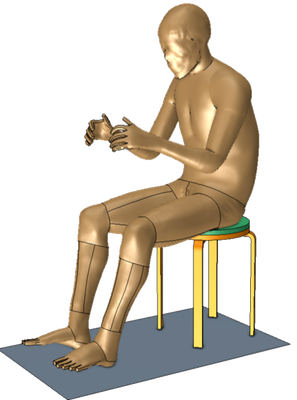
The THUMS model
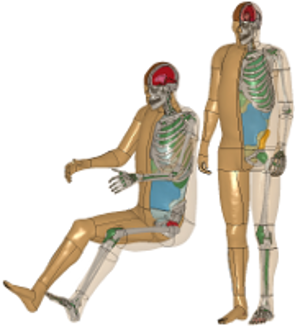
The Total Human Model for Safety (THUMS) is a human body FE-model developed by Toyota. The model is capable of simulating human body injuries, such as bone fracture and damage to the brain and internal organs in e.g. a vehicle crash. In contrast to the ATDs, the material models and geometry of the THUMS are intended to represent the tissue, bones and muscles of a real physical person.
From January 2021, the model is available without a license cost, under some conditions. For more information, contact your local LS-DYNA distributor.
The model is available for different genders, ages and physiques. The present case study is based on THUMS AM50 (v6.1), which represents an average adult male.
Method
A basic model of a stool in two versions was developed – with and without a cushion. Material data for the cushion were taken as typical values for a car seat.
Using the THUMS AM50 (v6.1) model as a starting point, modifications were made in order to obtain the required analysis results faster: The active muscles were removed, and the upper body was rigidized, represented by its mass and inertial properties. The main areas of interest, which were the upper legs and the bottom, were left deformable.
Analyses were then performed using the explicit and the implicit mechanical solver of LS-DYNA. For the implicit analyses, the original definitions of *MAT_FABRIC were slightly modified: FORM =-14 was used, with estimated coating values. In addition to this, contacts were switched to the Mortar formulation for the implicit simulations.

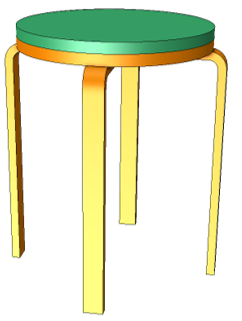
Gravity loading by mixed boundary conditions
The HBM was placed on the stool and gravity loading was applied. The objective was to reach quasi-static equilibrium. Initially, the rigidized upper body was fully constrained. The simulation started with a prescribed motion of the seat. When the contact force between the HBM and the seat reached 700 N, a sensor was triggered that stopped the motion of the seat. All translations (X,Y,Z) of the rigid upper body were released when this sensor was triggered. Rotations remained fixed. Additionally, in the explicit analyses, global mass damping was activated by this sensor. Gravity is active during the entire simulation and working towards equilibrium.
The implicit analyses were set up using a multi-stage approach:
- Stage 1: The motion of the seat was prescribed and the upper body fixed, performed as a static analysis. Stage 1 was terminated when the contact forces on the dummy reached 700 N. Then Stage 2 starts automatically, using the *CASE – functionality.
- Stage 2: The translations of the upper body were released, performed using implicit dynamics. Quasi-static equilibrium was found after approximately 1 s of problem time.
Results
Explicit analysis: Animation, seating without cushion
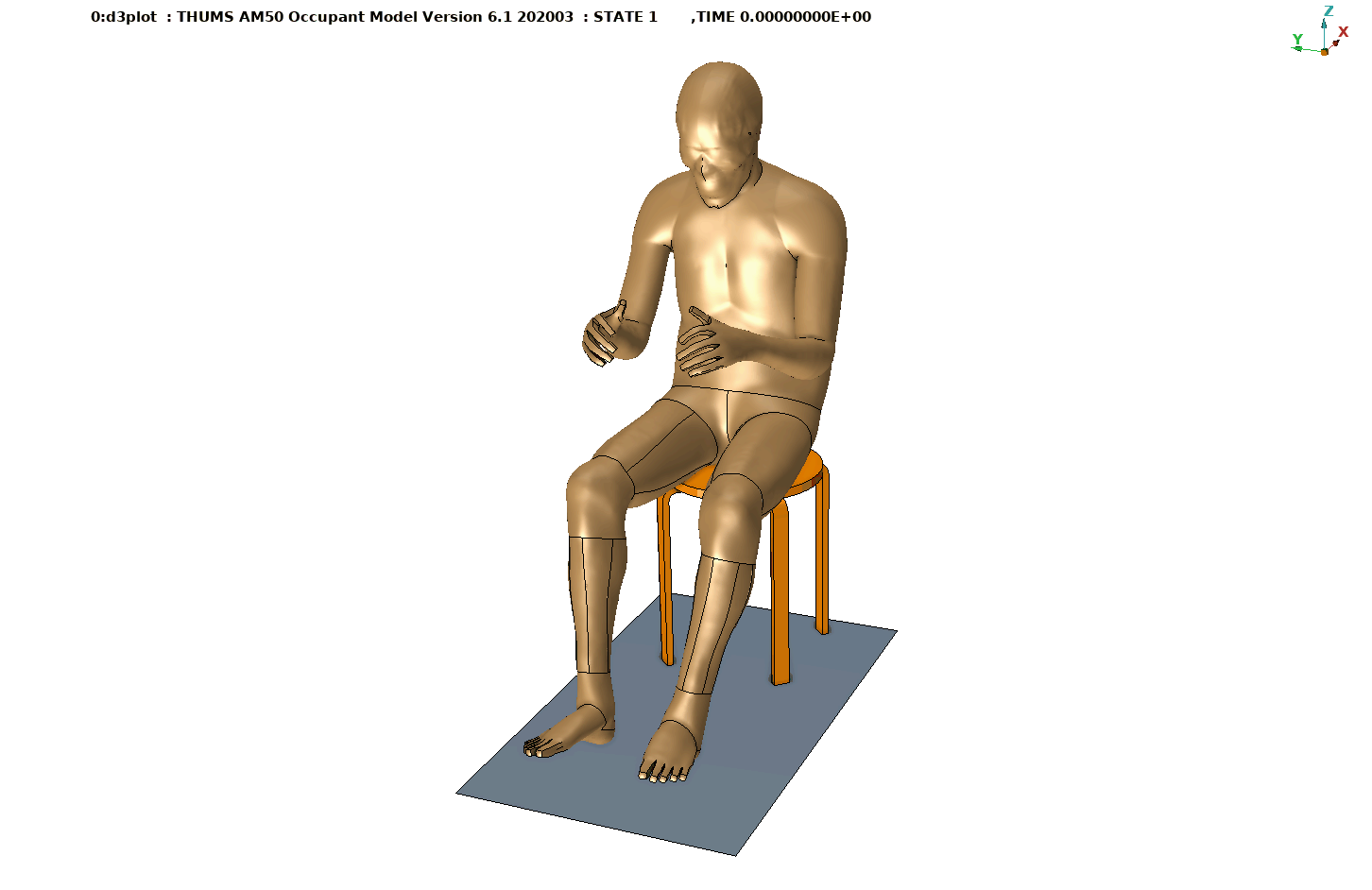
Implicit analysis: Animation, seating with cushion

As can be seen above, in the explicit analyses, both stool and floor were moved simultaneously. In the implicit analysis on the other hand, it was beneficial for convergence to place the floor as initially touching the HBM’s feet. The floor was then moved down to its final position.
Explicit analysis: Animation, cushion deformation
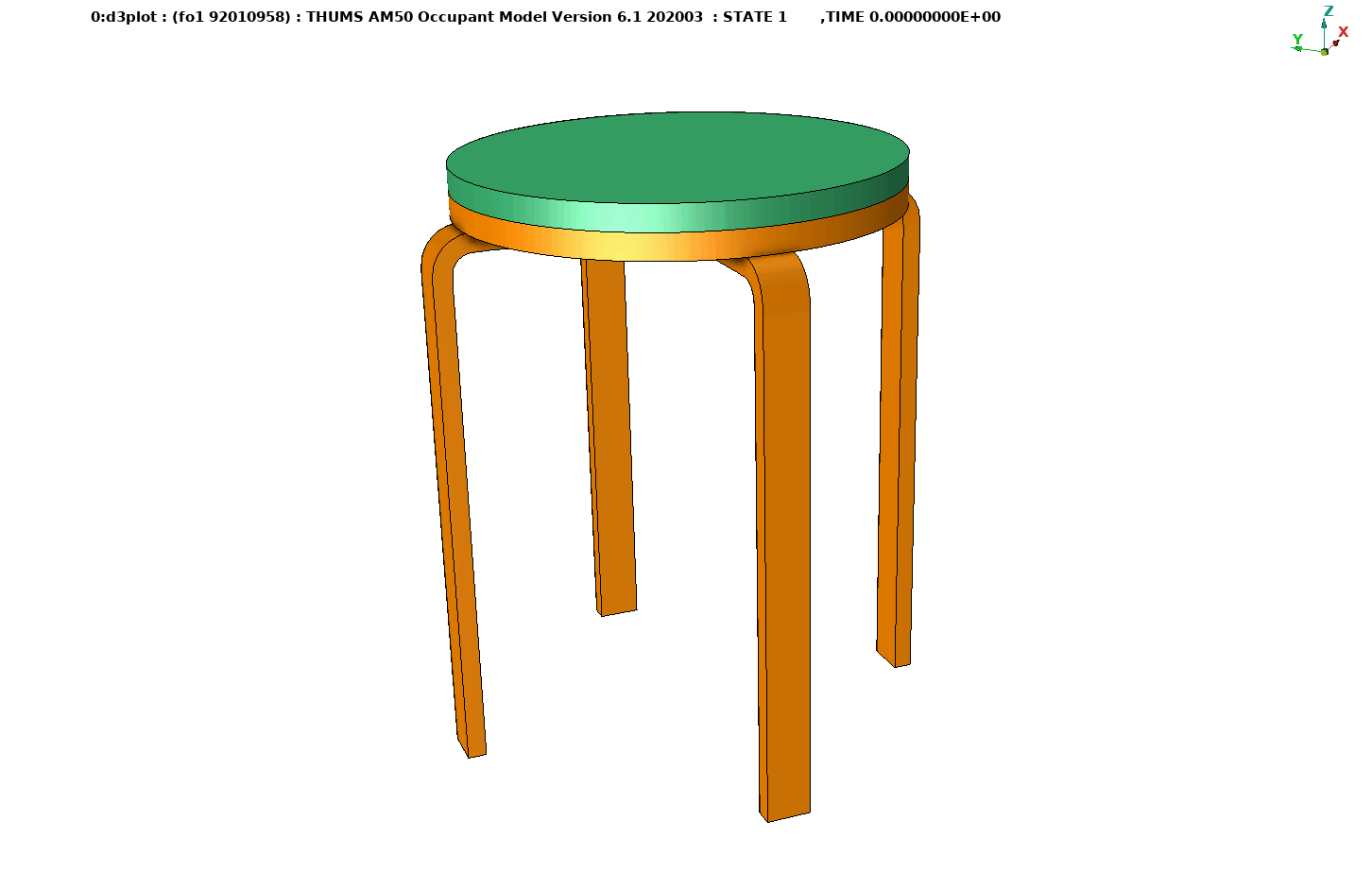
Implicit analysis: Animation, cushion deformation

Similar deformation of the cushion is obtained for both explicit and implicit analyses. In implicit, the foam was modelled using Cosserat Point elements.
Explicit analysis: Forces on the HBM

Implicit analysis: Forces on the HBM

For both explicit and implicit analyses, the steady state force balance was reached well before termination time. The final total force is quite similar between explicit and implicit, but some small differences in the distribution of the force between seat and floor can be noted.
Explicit analysis: Contact pressure without cushion

Implicit analysis: Contact pressure without cushion

Max 0.210 MPa
Max 0.220 MPa
The imprint of the relatively sharp edge of the stool seat in the thighs is clearly visible as red areas in the fringe plot. Areas like this, with concentrated relatively high contact pressures, indicate poor seating comfort.
Explicit analysis: Contact pressure with cushion

Implicit analysis: Contact pressure with cushion

Max 0.053 MPa
Max 0.065 MPa
Adding a cushion helps to distribute the contact pressure and reduces the peak value significantly.
Computational resources
For explicit, the LS-DYNA R12.1 mpp single-precision solver was used running on 40 cores, while for the implicit simulations, the LS-DYNA R13.1 mpp double-precision solver was used running on 16 cores. Simulation results were only presented above for some of the studied model versions, the table here has a few more examples to give you an idea of the computational resources spent.
The explicit solution is seen to provide the fastest solution times. For the implicit solution, the analysis with a cushion was faster than without, which is believed to be due to that the contact becomes smoother at the edge of the seat.
| Solver | THUMS modification | Cushion | Problem time (s) | Solution time (h) |
| Explicit | Rigid upper body | No | 0.5 | 4.8 |
| Explicit | Rigid upper body | No | 1.0 | 9.2 |
| Explicit | Rigid upper body | Yes | 0.5 | 5.9 |
| Explicit | Fully deformable | No | 0.5 | 31.2 |
| Implicit | Rigid upper body | No | 2.0* | 14.5 |
| Implicit | Rigid upper body | Yes | 2.0* | 10.6 |
*For the dynamic stage 2.
In conclusion
The development of HBMs, based on geometry and material data from physical humans, opens for new analysis possibilities within biomechanics. In the present case study, the highly advanced THUMS model, originally developed for injury assessment of the human body in vehicle collisions, was used in a study of seat comfort.
Some simplifications of the THUMS were made, in areas of less importance to the present scope, in order to decrease solution time. The explicit solver provides the fastest solution times, within a feasible range for use in for example optimization of cushion design or material properties in order to obtain a smooth contact pressure distribution and reduce contact pressure peaks.
With some minor model modifications, the implicit solver can also be used for this type of analyses involving advanced HBMs.
To learn more
Simulations have time and again proven to be a cost-effective product development tool that avoids costly tooling redesign. We have the software and knowledge required so that you may learn to perform these simulations yourself. We will guide you all the way, including training and support. To learn more, please contact one of our technical experts listed on this page.